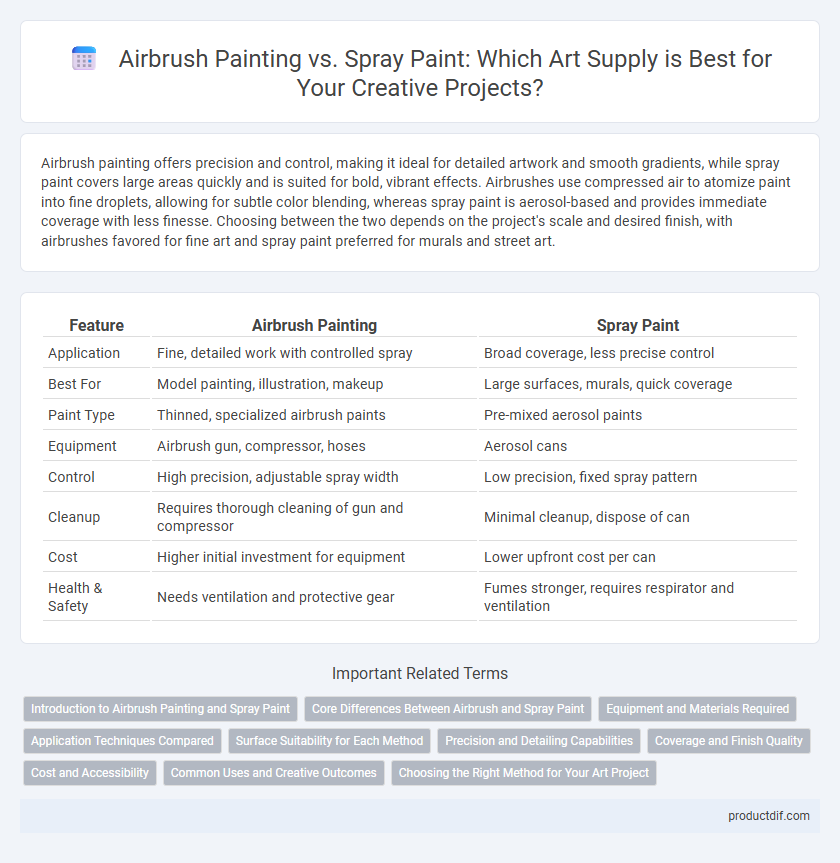Airbrush painting offers precision and control, making it ideal for detailed artwork and smooth gradients, while spray paint covers large areas quickly and is suited for bold, vibrant effects. Airbrushes use compressed air to atomize paint into fine droplets, allowing for subtle color blending, whereas spray paint is aerosol-based and provides immediate coverage with less finesse. Choosing between the two depends on the project's scale and desired finish, with airbrushes favored for fine art and spray paint preferred for murals and street art.
Table of Comparison
| Feature | Airbrush Painting | Spray Paint |
|---|---|---|
| Application | Fine, detailed work with controlled spray | Broad coverage, less precise control |
| Best For | Model painting, illustration, makeup | Large surfaces, murals, quick coverage |
| Paint Type | Thinned, specialized airbrush paints | Pre-mixed aerosol paints |
| Equipment | Airbrush gun, compressor, hoses | Aerosol cans |
| Control | High precision, adjustable spray width | Low precision, fixed spray pattern |
| Cleanup | Requires thorough cleaning of gun and compressor | Minimal cleanup, dispose of can |
| Cost | Higher initial investment for equipment | Lower upfront cost per can |
| Health & Safety | Needs ventilation and protective gear | Fumes stronger, requires respirator and ventilation |
Introduction to Airbrush Painting and Spray Paint
Airbrush painting utilizes a precision tool that sprays a fine mist of paint, allowing for detailed, controlled layering ideal for artwork requiring gradients and intricate designs. Spray paint is aerosol-based, providing quick coverage over larger surfaces, making it suitable for murals, graffiti, and outdoor projects. Both methods offer distinct advantages in texture and finish, with airbrushing favored for subtle effects and spray paint preferred for bold, expansive applications.
Core Differences Between Airbrush and Spray Paint
Airbrush painting offers precision with fine detail control and is ideal for delicate artwork, using compressed air to atomize paint into a smooth, even mist. Spray paint provides broader coverage, suitable for larger surfaces and faster application, but lacks the nuanced control of an airbrush. The key difference lies in the spray pattern and application technique: airbrushes produce thin, consistent layers for detailed work, while spray paint delivers thicker, more textured coats for robust, large-scale projects.
Equipment and Materials Required
Airbrush painting requires specialized tools such as an airbrush gun, compressor, and fine paint designed for smooth, controlled application, often allowing for detailed and precise work. Spray paint involves aerosol cans or paint sprayers designed for larger coverage, utilizing thicker paint formulations suited for quick, broad applications. Equipment costs for airbrushing tend to be higher due to the need for compressors and maintenance, while spray paint offers a more portable and user-friendly option with minimal setup.
Application Techniques Compared
Airbrush painting employs fine, controlled sprays of paint through a compressed air system, allowing for precise detailing and smooth gradient effects ideal for intricate artwork and custom designs. Spray paint uses aerosol cans to deliver broader, less controlled paint coverage suited for large surfaces, quick application, and street art. Mastery of airbrush techniques requires practice in controlling air pressure and paint flow, while spray painting demands skill in distance, angle, and layering to avoid drips and achieve even coats.
Surface Suitability for Each Method
Airbrush painting excels on small to medium surfaces that require intricate detailing, such as model kits, canvas art, and custom illustrations, due to its fine nozzle control and precision. Spray paint is better suited for larger, flat surfaces like walls, furniture, and vehicles, where quick coverage and uniform coat thickness are essential. The porosity and texture of the surface influence adherence; airbrush paint works effectively on smooth, primed surfaces while spray paint can adapt to rougher substrates with appropriate primers.
Precision and Detailing Capabilities
Airbrush painting offers exceptional precision and fine detailing capabilities due to its controlled airflow and adjustable nozzle size, allowing artists to create smooth gradients and intricate designs. Spray paint, while efficient for covering large areas quickly, generally lacks the finesse required for detailed work and precision edges. For projects demanding meticulous control and subtle shading, airbrush tools provide superior accuracy compared to traditional spray paint methods.
Coverage and Finish Quality
Airbrush painting offers precise control and smooth, fine coverage ideal for detailed artwork, achieving a high-quality, even finish with minimal overspray. Spray paint provides broader coverage rapidly, making it suitable for large surfaces but may result in less uniform finish due to heavier paint application. Artists choose airbrush for intricate designs and spray paint for fast coverage, balancing finish quality and efficiency.
Cost and Accessibility
Airbrush painting typically requires a significant initial investment in specialized equipment such as compressors, airbrushes, and cleaning kits, which can make it less accessible for beginners or casual artists. In contrast, spray paint offers affordability and convenience, with widely available aerosol cans that require no additional tools or setup. While airbrushes provide precision and control for detailed work, spray paint remains the cost-effective and accessible option for large-scale or quick applications.
Common Uses and Creative Outcomes
Airbrush painting offers precision and fine detail ideal for custom illustrations, model painting, and intricate designs, allowing artists to achieve smooth gradients and subtle color transitions. Spray paint excels in covering large surfaces quickly, making it popular for graffiti, murals, and industrial applications where bold colors and texture are desired. Both techniques provide unique creative outcomes, with airbrush enabling controlled, delicate effects and spray paint delivering vibrant, dynamic finishes.
Choosing the Right Method for Your Art Project
Airbrush painting offers precise control and fine detail, making it ideal for intricate artwork and smooth gradients, while spray paint provides faster coverage suitable for large surfaces and bold statements. Consider the scale, texture, and level of detail in your project to determine which method aligns best with your artistic goals. Factors such as ventilation requirements, substrate compatibility, and drying time also play crucial roles in selecting the optimal technique for your art supply needs.
Airbrush painting vs Spray paint Infographic

 productdif.com
productdif.com